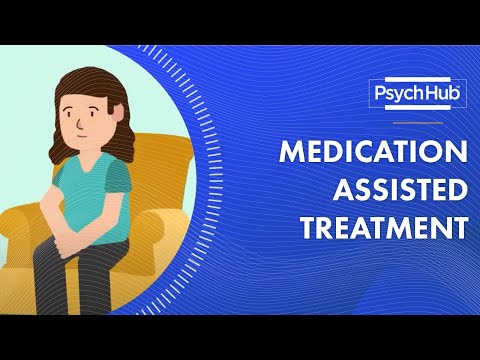What You Need to Know about Medication-Assisted Therapy
Contents
- What is Medication-Assisted Therapy?
- The Benefits of Medication-Assisted Therapy
- The Risks of Medication-Assisted Therapy
- How Medication-Assisted Therapy Works
- Who Can Benefit from Medication-Assisted Therapy?
- Who Should Not Use Medication-Assisted Therapy?
- How to Find a Medication-Assisted Therapy Provider
- What to Expect from Medication-Assisted Therapy
- The Cost of Medication-Assisted Therapy
- Medication-Assisted Therapy Success Stories
MAT is a holistic approach to treating addiction that involves the use of FDA-approved medications, along with counseling and behavioral therapies.
Checkout this video:
What is Medication-Assisted Therapy?
Medication-Assisted Therapy (MAT) is the use of FDA-approved medications, in combination with counseling and behavioral therapies, to provide a “whole-patient” approach to the treatment of substance use disorders.
MAT is an evidence-based practice that has been shown to be effective in helping patients reduce or stop their use of illicit drugs and alcohol. When used as part of a comprehensive treatment plan, MAT can help patients regain control of their lives and improve their overall health and well-being.
The Benefits of Medication-Assisted Therapy
Medication-assisted therapy (MAT) is a treatment approach that combines the use of medications with counseling and behavioral therapies to provide a “whole-patient” approach to treating substance use disorders.
MAT is an evidence-based practice that has been shown to be effective in treating opioid use disorder, and can help people reduce or stop their illicit drug use and return to productive lives. It is important to note that MAT is not a cure for addiction, but it can help patients manage their disease and achieve long-term recovery.
There are many benefits of medication-assisted therapy, including:
· Reduced risk of overdose and death: MAT reduces the risk of overdose and death by keeping patients engaged in treatment and providing them with tools to manage their disease.
· Improved patient outcomes: MAT has been shown to improve patient outcomes, including reducing the risk of HIV transmission and increasing retention in treatment.
· Cost-effective: MAT is a cost-effective treatment approach, as it reduces the need for costly hospitalizations and other medical interventions.
The Risks of Medication-Assisted Therapy
While medication-assisted therapy (MAT) is a safe and effective treatment option for addiction, there are some risks associated with it. These risks include:
-Dependence on the medication: Some people may become dependent on the medication used in MAT, such as buprenorphine or methadone. This means that they will need to continue taking the medication to avoid withdrawal symptoms.
-Interactions with other drugs: The medications used in MAT can interact with other drugs, including over-the-counter medications and illegal drugs. This can lead to dangerous side effects or even death.
-Misuse of the medication: Some people may misuse the medication by taking it more often than prescribed or by selling it to others. Misuse of MAT medications can lead to addiction or overdose.
How Medication-Assisted Therapy Works
Medication-assisted therapy (MAT) is the use of medication, in combination with counseling and behavioral therapies, to provide a “whole-patient” approach to the treatment of substance use disorders. Medications used in MAT are approved by the U.S. Food and Drug Administration (FDA) to treat addiction and are provided in a clinical setting under the direction of a licensed provider.
The use of medication in the treatment of addiction is not new; Medical professionals have been prescribing medications to patients with alcohol use disorders for many years. What is new is our understanding of how these medications work in the brain to help people recover from addiction. We now know that addiction is a chronic brain disease that affects both behavior and brain function. Medications used in MAT target specific areas of the brain affected by addiction, helping to normalize brain function and restore self-control.
MAT is not a “quick fix” or “cure” for addiction; it is a long-term treatment regimen that requires close monitoring and support from medical and counseling professionals. MAT is most successful when it is part of a comprehensive treatment plan that includes counseling, behavioral therapies, and other support services.
Who Can Benefit from Medication-Assisted Therapy?
Medication-assisted therapy (MAT) is a treatment approach that combines behavioral therapy and the use of medications to treat substance use disorders. MAT is effective in helping people to recover from addiction and can be used to treat alcohol, opioid, and tobacco use disorders.
There are many misconceptions about who can benefit from medication-assisted therapy. Some people believe that only people with severe addictions can benefit from MAT, but this is not true. Medication-assisted therapy can be an effective treatment for people with mild, moderate, or severe addiction.
People of all ages can benefit from medication-assisted therapy. MAT is often used to treat young adults who are struggling with addiction. This age group is more likely to respond well to treatment that combines medication and behavioral therapy.
Medication-assisted therapy is also effective in treating older adults with addiction. This population often has other health conditions that need to be taken into account when choosing a treatment approach. Medication-assisted therapy can help older adults to manage their addiction and improve their overall health.
Who Should Not Use Medication-Assisted Therapy?
Patients who are actively using substances or are in a substance-induced intoxication or withdrawal state should not use medication-assisted therapy. Medication-assisted therapy is also contraindicated for patients who are pregnant or breastfeeding.
How to Find a Medication-Assisted Therapy Provider
If you or someone you care about is struggling with opioid addiction, you may be considering medication-assisted therapy (MAT) as part of treatment.MAT involves using medications, such as buprenorphine or methadone, in combination with counseling and behavioral therapies to provide a “whole-patient” approach to treatment.
There are many things to consider when choosing a MAT provider, such as whether they are certified by the Substance Abuse and mental health Services Administration (SAMHSA) and whether they accept your insurance. This guide will help you understand what to look for in a MAT provider and how to find one near you.
What Is Medication-Assisted Therapy?
Medication-assisted therapy (MAT) is the use of medications, in combination with counseling and behavioral therapies, to provide a “whole-patient” approach to the treatment of substance use disorders. The FDA has approved three medications for MAT: buprenorphine, methadone, and naltrexone.
Buprenorphine is a partial opioid agonist that works by binding to the same receptors in the brain as opioids but with less intensity, reducing cravings and helping to prevent withdrawal symptoms. It can be prescribed by any certified physician and dispensed at a pharmacy.
Methadone is an opioid agonist that works by binding to the same receptors in the brain as opioids but with less intensity, reducing cravings and helping to prevent withdrawal symptoms. It can only be dispensed at federally regulated methadone clinics.
Naltrexone is an opioid antagonist that works by blocking the receptors in the brain that opioids bind to, preventing opioids from having an effect. It can be prescribed by any certified physician and dispensed at a pharmacy.
How Do I Find a Medication-Assisted Therapy Provider Near Me? The Substance Abuse and mental health Services Administration (SAMHSA) maintains a directory of buprenorphine/naloxone providers as well as state-licensed/certified opioid treatment programs . You can search for providers by location, type of service (e.g., office-based buprenorphine/naloxone), certifications/licensure (e.g., SAMHSAcertified), language spoken, payment accepted (e.g., Medicaid), and whether providers are accepting new patients . You can also call SAMHSA’s National Helpline at 1-800-662-HELP (4357) for free and confidential information on treatment facilities near you .
What to Expect from Medication-Assisted Therapy
If you or someone you love is struggling with addiction, you may have heard of medication-assisted therapy (MAT). MAT is a treatment option that combines medication with behavioral therapy to help people recover from addiction.
MAT can be an effective treatment for addiction, but it’s not right for everyone. It’s important to learn about MAT and to speak with a healthcare provider to see if it’s right for you or your loved one.
MAT is most commonly used to treat addiction to opioids, such as heroin or prescription painkillers. Medications used in MAT include buprenorphine and methadone. These medications help reduce withdrawal symptoms and cravings, making it easier for people to stick with treatment.
Behavioral therapy is an important part of MAT. It can help people identify the thoughts and behaviors that contribute to their addiction. It can also teach people skills to manage their addiction and cope with triggers.
If you’re considering MAT, it’s important to speak with a healthcare provider who can help you understand the risks and benefits of this treatment option.
The Cost of Medication-Assisted Therapy
There is no single answer to the question of how much medication-assisted therapy (MAT) will cost. The price of MAT will vary depending on the type and brand of medication used, the length of treatment, and the individual’s insurance coverage.
MAT is typically covered by insurance, but the out-of-pocket costs will vary depending on the insurer. Some insurers may require patients to pay a copay for each visit, while others may require a deductible or coinsurance.
Patients who do not have insurance may be able to get assistance through government programs or pharmaceutical assistance programs For example, the federal government’s Medicare program covers MAT for eligible individuals. The cost of MAT can also be reduced through the use of generic medications.
Medication-Assisted Therapy Success Stories
Accomplishing long-term sobriety is possible with the help of medication-assisted therapy, or MAT. This comprehensive treatment approach combines behavioral therapy and medication to address both the physical and psychological aspects of addiction.
While MAT has been shown to be an effective treatment for addiction, there are still some misconceptions about how it works. Here, we dispel some of those myths and share a few inspiring stories of people who have found success with MAT.
MAT is often used to treat opioid addiction, but it can be effective for other types of substance abuse as well. The medication used in MAT varies depending on the type of addiction being treated. For example, methadone is commonly used to treat opioid addiction, while naltrexone is used for alcohol dependence.
Behavioral therapy is an essential component of MAT. This type of therapy can help patients develop healthy coping mechanisms, manage triggers and cravings, and improve their overall wellbeing.
MAT is not a replacement for traditional treatment methods like detoxification and 12-step programs. Instead, it should be used in addition to these other treatments to provide a comprehensive care plan for recovery.
People who undergo MAT can experience significant improvements in their physical and mental health as well as their overall quality of life. If you or someone you know is struggling with addiction, don’t hesitate to reach out for help.







